A Comprehensive Guide to the Thomas Kilmann Conflict Model
Conflict is natural and unavoidable. But managing it effectively can be a challenge. Luckily, the Thomas Kilmann Conflict Model provides a framework that categorises different conflict-handling styles, helping HR professionals, leaders, and managers understand the responses of their co-workers and employees during such situations. Reasons such as these inspired the development of this model in the 1970s by Dr Thomas and Dr Kilmann, hence its name. With that, let’s explore how you can benefit from using this model today.
Article Overview:
- What is the Thomas Kilmann Theory on Conflict?
- What Are the 5 Thomas Kilmann Conflicts Modes?
- The Story of the Two Painters
- Assessing Your Conflict Management Style
- Advantages and Disadvantages of the Thomas Kilmann Conflict Model
- Comparing the Thomas Kilmann Conflict Model to Other Conflict Resolution Models
- Training and Development Programs to Improve Conflict Management Skills
- Recap of the Key Practices
Why is the Model Important?
Knowing the Thomas and Kilmann conflict styles can help you better navigate conflicts, interpret behaviours and choose appropriate strategies. For instance, the model illustrates that a ‘collaborating’ approach is ideal for achieving win-win resolutions, whereas a ‘competing’ stance suits scenarios demanding swift, decisive action.
Conversely, an ‘accommodating’ strategy prioritises harmony preservation over personal needs, making it invaluable in maintaining organisational cohesion. This model thus equips individuals with insights to effectively manage conflicts and foster productive outcomes. You will see this later with the story of the two painters.
1) What is the Thomas Kilmann Theory on Conflict?
The Thomas and Kilmann Conflict Model is a popular framework for understanding different approaches to conflict resolution. This model identifies five key conflict management styles based on two underlying dimensions: assertiveness and cooperativeness. In other words, how much focus do you place on your own needs and how much do you place on the other person’s needs? In any conflict, you may respond in one of these 5 ways as seen below.
Click the image below for a larger version.
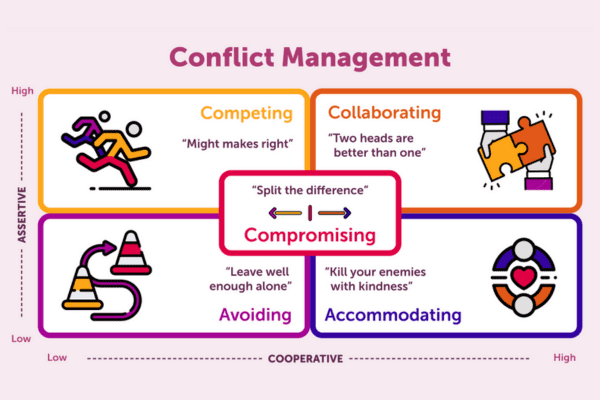
Overall, the Thomas Kilmann Model works with quite a simple format (as seen above) which is a 2×2 matrix using “Assertive” and “Cooperative” as the X and Y axes. In this way, we can have a clear visual of the placing of each of the 5 styles within their levels of each of the axes.
The one style that is featured in the middle (even levels of Assertive and Cooperative) is the Compromising style. The other four have distinct differentiating levels between the 2 axes. Here are the 4 other combinations that will occur.
- High Assertiveness and Low Cooperativeness = Competition.
- Low Assertiveness and High Cooperativeness = Accommodation.
- Low Assertiveness and Low Cooperativeness = Avoidance.
- High Assertiveness and High Cooperativeness = Collaboration.
Throughout this article, we will give more explanation about how these combinations work (or don’t) and what to be aware of for best practices.
Well, let’s see those five conflict management styles identified by the Thomas Kilmann Conflict Model again:
- Competing
- Collaborating
- Compromising
- Avoiding
- Accommodating
Sticky Learning ® is 7 times more effective than 1-day training courses. Plus, you will get a Chain of Evidence proving your Return on Investment. Discover soft skills training that changes behaviours long term.

2) What Are the 5 Thomas Kilmann Conflicts Modes?
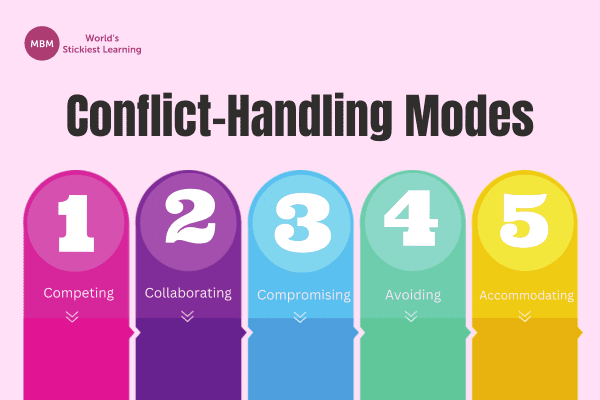
#1- Competing Style
First, the competing style is marked by high assertiveness and low cooperativeness. In other words, there is more focus on your needs over the other person’s needs. This style is suitable in situations where:
- Prompt action is required
- A decision needs to be made swiftly
However, overusing this style can cause damaged relationships and reduced trust. Remember, this style is about creating a result that is very much “I win – You lose”.
Examples of Use of the Competing Style
So, let’s have a look at some possible situations where this approach would be the more effective of the 5 to use.
- When you know you are right and the stakes are high, so you need to stand your ground.
- There is a sense of urgency and you need to make a quick decision that doesn’t include input or debate.
- In some cases, people simply want to be right and will not let the conflict go until they are proven right.
#2- Collaborating Style
Next, individuals who utilise the collaborating style of the Thomas Kilmann Conflict Model, demonstrate high levels of assertiveness and cooperativeness. Basically, you assert your own needs and concerns while also being highly receptive and responsive to the other person’s needs. Ideally, use this style more than others, simply because the style promotes a Win-Win situation. This is the complete opposite of avoiding as you’ll soon learn. It is also an improvement on where the compromising falls short.
Examples of Using the Collaborating Style
- When you have mutually similar goals to achieve and can work closely together to get the best results for all involved.
- Negotiating cross-departmental/interpersonal tasks that can be exchanged or delegated for increased productivity and achieving the company/department goals.
#3- Compromising Style
Here, individuals who use the compromising style exhibit moderate assertiveness and cooperativeness. In other words, you assert some of your needs while also accommodating the other person’s needs to a certain extent. This style falls intermediate between competing and accommodating. Though this may result in a win-win, there is the risk that no one fully gets what they want.
There are a number of mixed advantages and disadvantages that often cancel each other out. The main challenge with this approach is the possibility of appearing indecisive.
Examples of Using the Compromising Style
- When you want to move on to more important tasks and you are willing to meet in the middle to resolve the matter.
- Getting a mutually agreed end result is more important than winning.
- Understanding that to move forward there needs to be give and take on both sides.
#4- Avoiding Style
Now, the avoiding style is characterised by low assertiveness and low cooperativeness. Basically, you do not focus on your own needs, nor do you focus on the other person’s concerns. This style is for avoiding conflict altogether, rather than engaging in a potentially difficult or uncomfortable situation.
Ideally, this is the style to stay away from the most. There are so many reasons to steer clear of this approach. Actually, I can’t stress how much it’s important to avoid this as a leader.
Examples of Using the Avoiding Style
- When petty issues take up unnecessary time and effort in terms of results.
- Where you have 1 or more members of the conflict who openly reject any conflict management options and are unwilling to listen, therefore, leading you to postpone the conflict resolution meeting/discussion.
#5- Accommodating Style
Finally, the accommodating style is characterised by low assertiveness and high cooperativeness. Here, you prioritise the other person’s needs and concerns over your own. This is the opposite of competing.
Examples of Using Accommodating Style
This style may be appropriate in situations where the relationship with the other party is more important than the end result of the conflict, or when the issue is not significant enough to warrant a more assertive approach.
3) The Story of the Two Painters
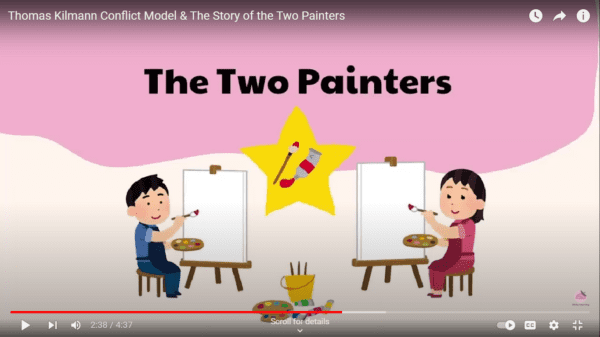
Picture two painters fighting over the last tube of red paint in the studio. Both painters wanted the red paint to complete their artwork for clients and argued over who should get it.
If one of the painters took a competing approach, then the other painter would lose out entirely, meaning that only one artwork would benefit from the red paint.
Another approach might be for both painters to walk away from the conflict, avoiding it altogether. In this case, neither of them would get the paint. This would result in both missing out and also the clients missing out on an amazing artwork.
Taking an accommodating approach, perhaps one of the painters could go and buy more red paint and give it to the other. This would be a very generous act, but it might mean they sacrifice their own needs for the sake of the other person’s needs.
Alternatively, they could compromise. They could share the tube of red paint, so each painter gets some, but the artworks would each receive only a fraction of the intended colour, leading to a less vibrant result.
The painters were actually working on two different pieces, one needing a lot of red and the other needing just a touch. If they had discussed their needs from the start, they would have realised that collaborating was the best approach.
Here, I showed you a useful explanation of the Thomas-Kilmann Conflict Mode Instrument and the five conflict-handling modes.
4) Assessing Your Conflict Management Style
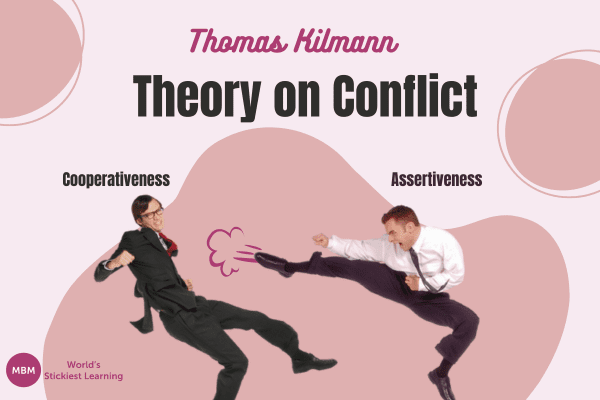
Assessing your conflict management style is crucial for effective conflict resolution. By understanding your tendencies and preferences when it comes to managing conflict, you can recognise when your approach may not be working and make necessary adjustments. Furthermore, being aware of your style can help you identify potential areas for growth and improvement.
One common method is to take the Thomas Kilmann Conflict Mode Instrument (TKI). It is an instrument or an assessment tool that measures an individual’s preferred conflict management style. Other synonyms for the Thomas Kilmann assessment are the TKI test, TKI questionnaire, TKI instrument, or more generally, the TKI Conflict Model. Take the Thomas Kilmann Instrument (TKI) directly from the person who co-created it, Dr. Ralph H. Kilmann. You will receive a report showing particulars such as a TKI profile which shows you your score for the Thomas Kilmann Conflict Mode Instrument. Percentile scores of 0 to 25 are considered low, percentile scores of 26 to 75 inclusive are considered medium, and percentile scores of 76 to 100 are considered high.
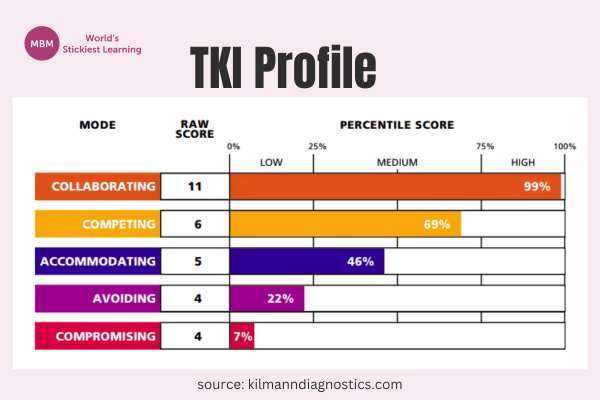
Other methods may include seeking feedback from colleagues, friends, or family members, or reflecting on past conflicts and considering how you responded in each situation. By taking the time to assess your style and reflect on past experiences, you can develop greater self-awareness and improve your ability to manage conflicts in the future. Even more are training courses like the one below.

Common Challenges in Implementing the Thomas Kilmann Conflict Model
While the Thomas Kilmann Conflict Model provides a valuable framework for managing conflicts, there are common challenges that can arise when attempting to implement the model. By understanding these challenges and developing strategies for overcoming them, individuals can improve their ability to manage conflicts effectively. So let’s explore some of these challenges.
#1: Resistance to Change
One common challenge is resistance to change. Note that implementing the Thomas Kilmann Conflict Model may require individuals to change their approach to conflict resolution, which can be difficult for some people. To overcome this challenge, it is important to communicate the benefits of using the model and provide training and support to individuals as they learn new conflict management strategies.
#2: Cultural Differences
Another challenge is cultural differences. The Thomas Kilmann Conflict Model is based on Western cultural values and may not be appropriate for all cultures or situations. When working with individuals from different cultures, it is important to be aware of cultural differences in communication and conflict resolution styles and to adapt strategies accordingly. This may involve seeking input and feedback from individuals from different cultural backgrounds and modifying the model to better align with cultural values and norms.
5) Advantages and Disadvantages of the Thomas Kilmann Conflict Model

The Thomas Kilmann Conflict Model provides a valuable framework for managing conflicts in a variety of settings. However, like any model, there are both advantages and disadvantages to using the model.
Advantages:
- Increased self-awareness: By using the Thomas Kilmann Conflict Model, individuals can assess their conflict management style and gain a greater understanding of how they approach conflicts. This increased self-awareness can lead to improved communication and more effective conflict resolution.
- Improved communication: The model emphasises the importance of communication and understanding the perspectives of others. By using the model, individuals can develop better communication skills and more effectively convey their perspectives while also understanding the perspectives of others.
Disadvantages:
- Limited scope: The Thomas Kilmann Conflict Model primarily focuses on individual conflict resolution and may not be as effective in addressing larger, systemic issues that may contribute to conflict.
- Cultural bias: The model is based on Western cultural values and may not be appropriate for all cultures or situations. It is important to be aware of cultural differences in communication and conflict resolution styles and to adapt strategies accordingly.
- Over-simplification: The model provides a useful framework for understanding different conflict management styles, but it may oversimplify the complexities of human exchanges and conflict resolution.
6) Comparing the Thomas Kilmann Conflict Model to Other Conflict Resolution Models
There are other models out there that we want to bring to your attention. Now let’s take a look.
#1: Interest-Based Relational (IBR) Approach
One popular model is the Interest-Based Relational (IBR) approach. The IBR approach focuses on identifying the underlying interests and needs of all parties involved in a conflict and working collaboratively to find a solution that meets the needs of all parties. This approach emphasises the importance of building relationships and trust between parties to effectively resolve conflicts.
While the Thomas Kilmann Conflict Model also emphasises the importance of communication and understanding the perspectives of others, it is more focused on individual conflict management styles rather than collaborative problem-solving.
#2: Harvard Negotiation Model
Another commonly used model is the Harvard Negotiation Model. This model emphasises the importance of:
- Separating people from the problem and focusing on interests rather than positions.
- Generating multiple options for mutual gain and using objective criteria to assess options.
While there are similarities between the Harvard Negotiation Model and the Thomas Kilmann Conflict Model, the Harvard model is more focused on negotiation and finding a mutually beneficial solution, while the Thomas Kilmann model is more focused on individual conflict management styles.
7) Training and Development Programs to Improve Conflict Management Skills
Training and development programs can be a valuable tool for improving conflict management skills using the Thomas Kilmann Conflict Model. These programs can be tailored to the needs of individuals or organisations and can help individuals develop the skills and strategies necessary to effectively manage conflicts.
- Provide individuals with an understanding of the Thomas Kilmann Conflict Model, including the different conflict management styles and when each style is most appropriate. Individuals can also learn how to assess their conflict management style and identify areas for improvement. This can be done through interactive workshops, case studies, and role-playing exercises.
- Give individuals practical strategies for managing conflicts in different situations. This can include strategies for managing conflicts with colleagues, customers, or other stakeholders.
8) Recap of the Key Practices
When all is said and done, we need to apply I.D.E.A.S. when dealing with conflict. Regardless of whether we’re using the Thomas Kilmann Conflict Model.

I: Investigate the Cause of the Issue
First, delve deep and find the root causes for issues and conflicts that are happening in your team.
D: Deal with Characters and Personalities
Next, know your team. Be prepared for potential outbursts, etc. that might surface. Remember, you are the leader. As such, you need to be ready to deal with all varieties of personalities and adjust your approach accordingly.
E: Empathy
Here, understand where people are coming from before making a judgment. In fairness, we don’t always know what people are going through. It can truly create great results.
A: Apply a Fair Approach
Ensure that conflict is handled fairly and without prejudice. The worst mistake we can make is going into a conflict situation with our minds already closed to potential new information or taking sides. Stay open and ready.
S: Solutions that Work
Finally, we need to ensure that we have ideas and solutions ready to resolve conflict. Here, we need to be ready to adapt and move between approaches for the best results.
Conclusion & Additional Help
In conclusion, the Thomas Kilmann Conflict Model provides a powerful framework for understanding and managing conflicts in various contexts. With its five conflict management styles and accompanying assessment tools, the model has been widely used by individuals and organisations to improve communication and collaboration and reduce conflict.
Do you want your team to better manage conflict internally and externally? This conflict resolution training course will give you the required skills.
Attention: Subscribe through LinkedIn to know when we publish a new article.
Updated: January 2024 by Ailish O’Rourke-Henriette




